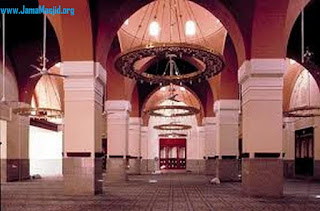During the 1980's, the Egyptian architect Abdel Wahed El-Wakil designed over a dozen mosques in Saudi Arabia. While these mosques differ in size, formal composition, and sources of financing, they nonetheless are umted by a number of general characteristics. Firstly, they can all be referred to as revivalist structures. All draw heavily, and often very directly, on various historical prototypes belonging to the architectural heritage of the Islamic world.
All these mosques share strong similarities in the use of materials and construction technologies Their construction is based on the utilisation of load bearing brick walls, vaults and domes. Therefore, these structures are built of hollow baked bricks held together with mortar Most of the brick surfaces are covered with white plaster, and in some cases, with granite. However, the interior of the vaults and domes are generally left exposed, and are only coated with a layer of browinsh paint. As for reinforced concrete, its use is limited to specific elements, which include the foundations, lintels, and flat ceiling.
The King Saud Mosque is the largest in the city of Jeddah. The mosque is characterised by a complex plan which is aligned with the surrounding streets on three sides, but is also aligned with the qibla direction on the fourth, or western side. The discrepancies between the street directions and that of the qibla are compensated for by the addition of triangular shaped areas. These additions contain ablution facilities, classrooms, storage rooms, offices and residences. Those entering through the main entrance need to make a number of consciously arranged axial shifts before reaching the courtyard around which the prayer hall is arranged.The four iwan prayer hall covers an area of 5000 sq m and is symmetrically composed around an east-west axis. In addition to the four barrel-vaulted iwans, its main features consist of a large dome reaching a span of 20 m, two smaller symmetrically arranged 12 m domes, and a series of small 6 m domes covering the remaining bays of the prayer hall.
King Saud Mosque is the largest mosque in the city of Jeddah and is located in Jeddah’s Al-Sharafeyyah District.
The Mosque was designed by Abdel-Wahed El-Wakil and was finished in 1987. It is mainly build of brick and covers an area of 9700 m² with the prayer hall alone covering 2464 m². The largest dome has a span of 20 meters and reaches a height of 42 meters. The Minaret reaches a height of 60 meters;
All these mosques share strong similarities in the use of materials and construction technologies Their construction is based on the utilisation of load bearing brick walls, vaults and domes. Therefore, these structures are built of hollow baked bricks held together with mortar Most of the brick surfaces are covered with white plaster, and in some cases, with granite. However, the interior of the vaults and domes are generally left exposed, and are only coated with a layer of browinsh paint. As for reinforced concrete, its use is limited to specific elements, which include the foundations, lintels, and flat ceiling.
The King Saud Mosque is the largest in the city of Jeddah. The mosque is characterised by a complex plan which is aligned with the surrounding streets on three sides, but is also aligned with the qibla direction on the fourth, or western side. The discrepancies between the street directions and that of the qibla are compensated for by the addition of triangular shaped areas. These additions contain ablution facilities, classrooms, storage rooms, offices and residences. Those entering through the main entrance need to make a number of consciously arranged axial shifts before reaching the courtyard around which the prayer hall is arranged.The four iwan prayer hall covers an area of 5000 sq m and is symmetrically composed around an east-west axis. In addition to the four barrel-vaulted iwans, its main features consist of a large dome reaching a span of 20 m, two smaller symmetrically arranged 12 m domes, and a series of small 6 m domes covering the remaining bays of the prayer hall.
King Saud Mosque is the largest mosque in the city of Jeddah and is located in Jeddah’s Al-Sharafeyyah District.
The Mosque was designed by Abdel-Wahed El-Wakil and was finished in 1987. It is mainly build of brick and covers an area of 9700 m² with the prayer hall alone covering 2464 m². The largest dome has a span of 20 meters and reaches a height of 42 meters. The Minaret reaches a height of 60 meters;




















Comments
Post a Comment